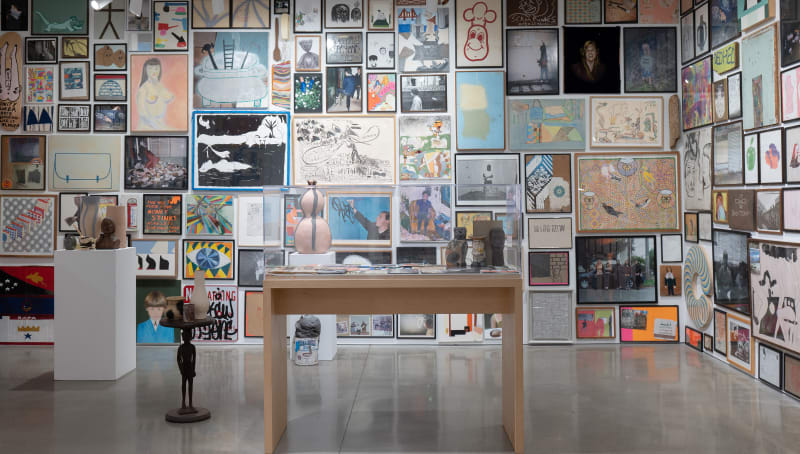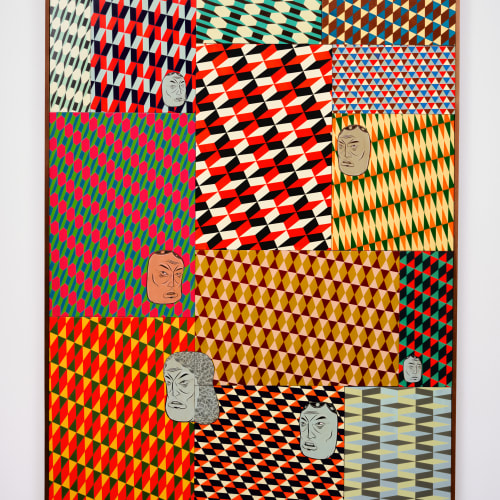Before heading directly into Yerba Buena Center for the Art's main gallery for Bay Area Then, start in the lobby coat room.
Gone are all the hangers. Instead, step inside and take in the excess of San Francisco artist Barry McGee's epic cluster installation of works that sprawls from the closet and up the walls of the lobby. His signature hanging style that packs together everything from works on paper, paintings and skateboarding photographs, creates a chaotic and energizing effect.
"Barry broke the threshold of where he was supposed to be presenting," said the exhibition's guest curator, Eungie Joo. The change even required a call to the organization's director, Mari Robles, to gain permission to expand the work beyond its original parameters.
"She took the call at 11:30 at night and agreed," Joo recalled. "This is the kind of leadership art spaces need - somebody who feels, ‘If these artists are going to go for it, I'm going to have to support them.'"
Bay Area Then, which focuses on artists from San Francisco's Mission School art movement of the 1990s, features pieces by 21 creators who helped shape the creative culture of the region in that decade. While mostly featuring new work, it manages to convey the excitement of the scene in that era, a kind of artistic entropy that bursts from the large-scale wall works and rambling installations.
Among the artists included are Nao Bustamante, Carolyn Castaño, Bill Daniel, Beatrix Fowler, Mike "Dream" Francisco, Chris Johanson with Ajax Oakford, Margaret Kilgallen, Josh Lazcano, Ruby Neri, Manuel Ocampo and Gina Osterloh.
Joo, who as a former curator at the San Francisco Museum of Modern Art was responsible for the ongoing Kara Walker Installation Fortuna and the Immortality Garden (Machine), has worked with many of these artists since the late ‘90s. But she wasn't interested in just putting quotation marks around that period of Bay Area art and presenting it in amber.
"I didn't see the project ever as nostalgic," said Joo. "I always thought, Yerba Buena is a place that was so important to our development as cultural practitioners, artists, curators, writers, community members. It actually gave a s- about that generation."
The latest show comes as YBCA is in the process of rebuilding its relationship with the local arts community following a period of turmoil.
During a public program in February 2024 supporting the "Bay Area Now" exhibition, several artists altered their work with slogans in support of a ceasefire in Gaza. YBCA responded by temporarily closing its galleries, a decision that prompted several employees to resign in protest. Although the show reopened with the altered works on view, the incident has marred the organization's reputation.
Based on several of the new pieces in Bay Area Then, it is clear that Robles - who took the organization's helm in January following a four-year stint as executive director at the Headlands Center for the Arts - is not afraid of confronting contemporary issues, including Gaza.
"When I started at YBCA I was really looking to get back to presenting great art," she said. "Eungie is such an incredible curator. It became clear very quickly that she was going to be able to organize something that was both impactful and also responsive to our time."
The 1990s and current moment rhyme in many ways. In that earlier decade, San Francisco faced displacement from the dot-com boom, just as artificial intelligence is la bubble du jour. The police beating of Rodney King then and the more recent killing of George Floyd both ignited reckonings over systematic injustice. The current anger and anxiety over national politics' impact on the arts and the humanitarian crisis in Gaza also echo conservative backlashes against the National Endowment for the Arts and international conflicts in that era.
"I presented it to the artists as, ‘I really think we have to share this message: Do not despair. We thought it was the end of the f-ing world, we were in our early 20s,'" said Joo. "I think that generation said, ‘We're going to build the world we can only imagine because there's no way that it could happen.'
"That is the kind of freedom that I think is why we care about art."
The exhibition sets the scene with memorabilia from the ‘90s, including flyers, zines and photos demonstrating the DIY, postpunk mood of the era. Kilgallen's final major installation, Main Drag, plunges visitors even deeper into the past.
Kilgallen, who was married to McGee, created the piece before she died in June 2001. Reinstalled for the first time since 2018, the work epitomizes her penchant for reinventing classic sign painting techniques. Main Drag shows illustrations of words including "kook" and "steady," with depictions of a Mission Street scene, and fills almost half the gallery on wall-mounted panels and wooden blocks. It not only celebrates Kilgallen's legacy but invites viewers to ponder what other contributions she would have made had breast cancer not claimed her at age 33.
Among the new work is Alicia McCarthy's mural spraypainted in the woven, intersecting lines that have become a recognizable signature. Johanson and Oakford installed their own wooden labyrinthine gallery structure that invites visitors to meander through and discover paintings hung along its pathways. It evokes the many ramshackle artist spaces that existed at the turn of the millennium.
But the centerpieces of Bay Area Then are undoubtedly the works that address Gaza, a notable move in light of the institution's recent history.
Gaza, by hip-hop educator and graffiti artist Spie One, is shown with an earlier banner collaboration, "Free Mumia," in support of Mumia Abu-Jamal, who in 1981 was convicted of murdering a police officer but has long declared his innocence. In Gaza, hands cradle plants that sprout green fists of resistance, visually tying the conflicts and protest art of then to now.
Rigo23's monumental mural Terra Nullius, which translates to "Nobody's Land," is an awe-inspiring juxtaposition of San Francisco and Gaza. In the work, Palestinian civilians are shown protesting, bullhorns raised. Overhead is San Francisco landmark Sutro Tower and drones. In the most haunting detail, San Francisco's ubiquitous self-driving cars serve as military tanks.
For Joo, the opportunity to present the show at YBCA was a full-circle moment. Arnold Kemp, one of the art center's first curators in the early '90s, was an inspiration to her, and now she's programming him.
"I can't say enough for the program that Renny Pritikin, René de Guzman and Arnold Kemp established Yerba Buena with," said Joo. "It really taught me a lot about contemporary art and I think has had great impact on my own work and thinking."
Kemp's own 2022 piece, Stage - a plywood work with letters that spell "I would survive, I could survive, I should survive" - feels like a fitting bridge between then and now. Those phrases are worthy credos for every San Francisco artist, no matter the era.
Correction: An earlier version of this story misstated Arnold Kemp's position at YBCA. Founding curator Renny Pritikin hired Kemp in 1993 as a junior curator.

